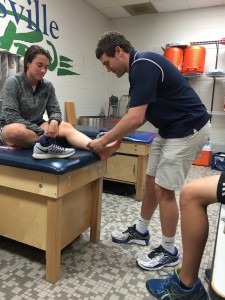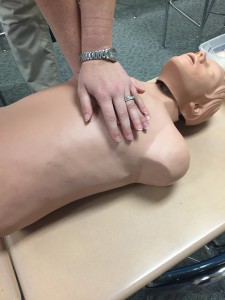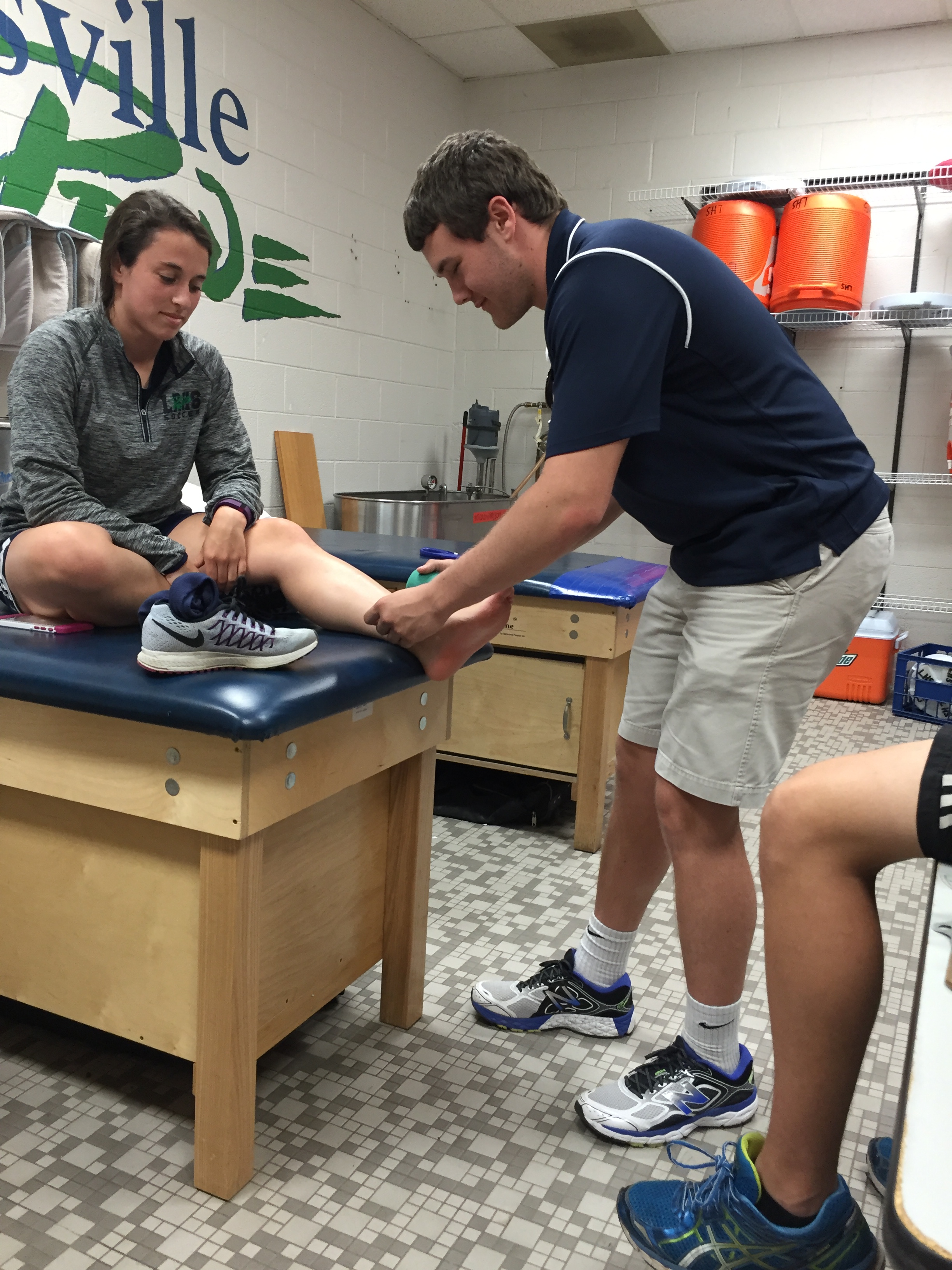Sports Medicine

Sports medicine teaches students life long skills. As they continue with the class, students appreciate and understand the importance of the teacher Susan Ennis’s lessons.
Sports Medicine is a popular class amongst both the students and the athletes at Leesville Road High School. Students participating in the class learn skills that will last them a lifetime. Meanwhile athletes understand, but don’t particularly like, the importance of rehab and taking care of their bodies after an injury.
Susan Ennis, sports medicine teacher, has four classes: sports med one, two, three, and four. In sports med one, students learn CPR, first aid, basics of athletic training, and how to become an athletic trainer. In sports med two, those participating in the class, learn about muscles and skeletal anatomy, common injuries that occur in each joint structure, and basic treatment protocol for each injury. In sports med three, Ennis focuses on rehab and modalities, and in four, students receive emergency response training from the American Red Cross. Over all, the students learn how to fulfill the six roles and responsibilities of an athletic trainer.
A common theme runs between both the students and athletes participating: interest in the human body and the excitement to understand learn how to help anyone if they are injured:
“When I was younger, I knew I wanted to do something medical and so I went to the sports medicine camps and got really interested,” said Alex Sohn, senior.
“I have always been interested in health, anatomy and stuff to do with the body. I think because I have been playing soccer for a while, [knowing how to treat my injuries the proper way has been a cool experience],” said Shannon Hardy, senior.
“I took sports med because it is interesting learning about the body and its anatomy. It is also fun learning about the different sports related injuries. [This class] helps you better understand injuries that happen to yourself. When I broke my wrist we were talking about fractures and [learning this new material] helped me take care of myself,” said Erica Jacobson, sophomore.
Being in the class requires a few things for students to be successful. “One, they have to be interested in medicine; two, they need to be able to volunteer after school because volunteering is a big requirement for each course. They [also] need to be responsible, dedicated, and they need to have leadership skills,” said Ennis.
Ennis does not lie when she said “volunteering is a big requirement.” Students in sports med one need to volunteer ten hours a quarter, sports med two needs to volunteer fifty hours a quarter, and three and four are honors classes requiring 100 hours a quarter.
Life Skills to Save A Life

Life is unpredictable. Learning CPR can prepare people for the unexpected. Everyone should have the skills to save a life if the opportunity arises.
Not only does the class teach lifelong skills, sports medicine certifies students in CPR and ensures that students are comfortable and able to use proper protocol. “It is an essential and basic skill that everyone should learn and it’s not very difficult at all,” said Sohn.
Learning CPR prepares students not only for possible incidents at school, but also for the unpredictability of life. “It made me more confident in any situation, no just sports medicine, like if I saw someone in a public situation and they need help, I would feel comfortable to [assist the person with the training I have taken],” said Sohn.
In order to be certified by CPR a class must be paid for and have a certified instructor by the American Red Cross. “I don’t think any of the health teachers on this campus are certified to do that or qualify to do that. They will have to go through a training. However, outside sources could be set up through the American Red Cross or the American Heart Association so that more kids could be certified or qualified. I think, in theory, learning general concepts can help, but I do think that it should be a requirement for students to be certified in CPR and first aid,” said Ennis.
Like many others, it was news to Sohn that healthful living did not certify student in CPR. Healthful living teachers spend “no longer than a few days on CPR and about two weeks on basic first aid,” said Jack Rogers, PE department chair and athletic director. “CPR is very important, but so is first aid, talking about drugs, and talking about the the mental, emotional, and physical sides of health. There is very limited time in health. Shortening one class to take more time on another (CPR), is tough to do,” said Rogers.
In health when teaching CPR, the teachers make sure students can use the proper form and then have a test seeing if a student can perform CPR properly. That is as far as they go.
“Since they {health teachers] can’t press kids into paying for the certification [steps should be taken to stricten the teaching process in health]. First, it should be taken much more seriously in class and secondly, taught by a certified individual [so training is accurate and effective],” said Sohn. Although the students taking health still won’t be certified, having a teacher who has learned the curriculum themselves can enhance the classroom experience.
Having a required class to teach CPR and first aid by a certified instructor is not an easy task. Being certified by the American Red Cross in first aid, CPR, and AED is not cheap, and Wake County doesn’t have the funding to pay for thousands of students to be certified. Since the county isn’t stable enough to spend thousands, it is important to spread the message of the importance of CPR in a different way. Health Teachers should understand the material and be able to use their knowledge to instill the importance of CPR on the impressionable minds of the young, especially since health is a required class.

Leave a Reply